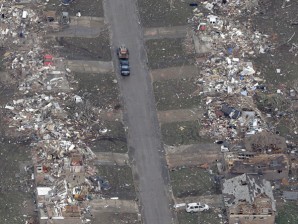
An aerial view of a street lined by homes destroyed by Monday’s tornado is shown Tuesday, May 21, 2013, in Moore, Oklahoma. Wind, humidity and rainfall combined precisely to create Monday’s massive killer tornado in Oklahoma. The awesome amount of energy released dwarfed the power of the atomic bomb that leveled Hiroshima. AP PHOTO/TONY GUTIERREZ
WASHINGTON—Wind, humidity and rainfall combined precisely to create Monday’s massive killer tornado in Oklahoma. The awesome amount of energy released dwarfed the power of the atomic bomb that leveled Hiroshima.
On Tuesday afternoon, the National Weather Service gave the tornado the top-of-the-scale rating of EF-5 for wind speed and breadth and severity of damage. Wind speeds were estimated at between 200 mph (320 kph) and 210 mph (337 kph).
Several meteorologists contacted by The Associated Press used real-time measurements to calculate the energy released during the storm’s life span of almost an hour. Their estimates ranged from 8 times to more than 600 times the power of the Hiroshima bomb, with more experts at the high end.
The tornado at some points was 1.3 miles (2 kilometers) wide, and its path went on for 17 miles (27 kilometers) and 40 minutes. That’s long for a regular tornado but not too unusual for such a violent one, said research meteorologist Harold Brooks at the National Severe Storms Laboratory.
Less than 1 percent of all U S tornadoes are this violent—only about 10 a year, he said.
With the third strong storm hitting the suburb of Moore in 14 years, some people are wondering why. It’s a combination of geography, meteorology and lots of bad luck, experts said.
If you look at the climate history of tornadoes in May, you will see they cluster in a spot—maybe 100 miles (160 kilometers) wide—in central Oklahoma “and there’s good reason for it,” said Adam Houston, meteorology professor at the University of Nebraska, Lincoln. That’s the spot where the weather conditions of warm, moist air and strong wind shear needed for tornadoes combine in just the right balance.
Several meteorologists also offered this explanation for why the suburb seemed to be hit repeatedly by violent tornadoes: “bad luck.”
Scientists know the key ingredients that go into a devastating tornado. But they are struggling to figure out why they develop in some big storms and not others.
They also are still trying to determine what effects, if any, global warming has on tornadoes.—Seth Borenstein